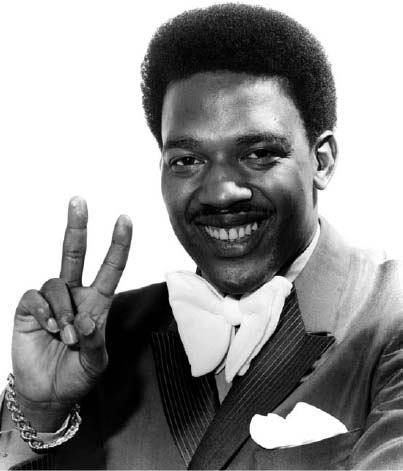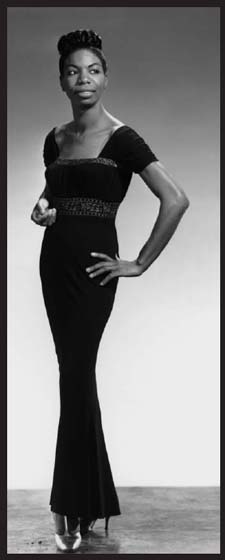The Encyclopedia of Dead Rock Stars (255 page)
Read The Encyclopedia of Dead Rock Stars Online
Authors: Jeremy Simmonds


As the world reverberated to reports of war in Iraq, the man whose anthem did so much to rally opposition to an earlier conflict passed away at his home near Nottingham. For Edwin Starr it was an ignominious end to a vibrant career in which in the space of a decade the singer bridged the gap between full-throated soul and bass-heavy disco. Starr began recording with the largely forgotten doo-wop outfit The Future Tones, before military service beckoned, pulling the fledgling singer away for two years. His take on The Temptations’ ‘War’ was a milestone in soul-music history, and certainly the most incendiary song ever issued by Motown. The singer had already breached Billboard’s Top Ten with the raunchy ‘25 Miles’ (1969) by the time ‘War’ took him to number one in August 1970, the stirring dancefloor packer a timely reminder of the disapproval felt by America’s youth at their country’s continued occupation of Vietnam. Suddenly, Starr was a spokesman (his presentation many years later of a BBC radio series on the civil rights movement was well conceived), and the song was destined to reemerge as a soundtrack staple throughout the next three decades. For Starr, the seventies were noticeably quieter after this resounding success, a move to the UK then seeing the singer reinvent himself once more. In 1979, his singles ‘Contact’ and ‘H.A.P.P.Y. Radio’ were both big UK disco hits, a gruff but pleasing antidote to the falsetto shrieks that seemed to occupy every other available second of airspace at the time following the success of
Saturday Night Fever
and the like. His sales thereafter faltering, Starr turned to a number of other luminaries (given that this includes Stock, Aitken & Waterman, the term is used advisedly) to reverse the trend. However, his only other notable hit was ‘Funky Music Sho Nuff Turns Me On’ – revamped by Leeds dance-collective Utah Saints in 2000.

Edwin Starr: ‘War’ resulted in victory
A long way from his birthplace of Nashville, Edwin Starr died of an apparent heart attack in his adopted home of Beeston, Nottinghamshire.
Thursday 10
Little Eva
(Eva Narcissus Boyd - Bellhaven, North Carolina, 29 June 1943)

Her aunt was ‘Big Eva’, so she, at less than five feet tall, was ‘Little Eva’ – simple as that. Like Edwin Starr, Eva Boyd was known primarily for one massive hit. Her unique voice was first chanced upon by the vigilant and influential songwriting couple Carole King and Gerry Goffin, who’d employed the young unknown as a nanny in 1961, having met her when she was working as a maid at the legendary Brill Building. Eva had already sung as a prominent member of her family’s gospel choir, and she herself devised the dance moves that were to accompany ‘The Loco-motion’, the astonishingly successful first release that shot her to number one in America in the fall of 1962. With ‘new dance’ ditties something of a phenomenon at the time, ‘The Loco-motion’ sold millions worldwide (number two in the UK), though fame was to be fleeting. After a couple of further US Top Twenty entries, the novelty of Little Eva’s shrill tones began to wear thin, her best outlet thereafter proving to be as a backing singer for acts like The Drifters. When she quit the business in 1971, Little Eva – who had earned just fifty dollars a week when she was at number one in an era when performance royalties were rarely paid – emerged as penniless as she’d been a decade earlier. Indeed, the former star was forced to return to menial work. When ‘The Loco-motion’ re-entered the UK charts in 1972, it’s said that Eva wasn’t even aware of the fact.
Kylie Minogue’s successful reigniting of Eva’s biggest song did, however, bring her out of retirement in the late eighties, the star recording a gospel album that performed better than was expected. She returned to the UK with Little Richard in 2001, but diagnosis with cervical cancer – from which she died two years later – was to curtail any longer-term plans of career revival.
Golden Oldies #14
Nina Simone
(Eunice Kathleen Waymon - Tryon, North Carolina, 21 February 1933)

Critics found her cold and aloof: she was simply ‘better’. As much a legend of soul and the blues as she was a jazz singer, Nina Simone’s effortless tremolo seemed to weave in and out of the delicate melodies with which she accompanied herself, her voice an amazingly sophisticated and versatile ‘instrument’ in its own right. Like so many others, Simone was inspired by religious music; she also studied piano at New York’s prestigious Juilliard Academy. She then suddenly became involved in the civil rights movement, in direct response to the fact that her parents had been moved from their front-row seats when watching her perform for the first time. This association - which later landed her in trouble for withholding income tax as protest - informed a number of her recordings, not least ‘To be Young, Gifted and Black’, though her biggest hits were ‘Ain’t Got No (I Got Life)’ (1968) and the reissued ‘My Baby Just Cares for Me’ (1987), both of which made the UK Top Five. Nina Simone had relocated to Provence, France, at the time of her death from cancer on 21 April 2003.

Nina Simone: Little girl blue
MAY
Tuesday 6
Gerry Shephard
(England, 28 December 1951)
The Glitter Band

He was never going to upstage Gary, but Gerry Shephard still cut a memorable seventies pop figure with his customized ‘star’ guitar – a prop he used until just months before his death. From 1972, The Glitter Band epitomized a working-class glamrock ethic: they were a pretty basic-looking bunch underneath it all, but poured into their glittering suits they were, if not essential, a visually arresting addition to
Top of the Pops
for a couple of years. Although never likely to match the success of original leader, Gary Glitter, the group built upon his trademark yelps and handclaps to run off seven sizeable hits of their own, including ‘Angel Face’, the admittedly brilliant ‘Just For You’ (both 1974) and ‘Goodbye My Love’ (1975). Beach Boy fan Shephard – very much the talent of The Glitter Band – died following a lengthy illness.
Sunday 11
Noel Redding
(Folkestone, England, 25 December 1945)
The Jimi Hendrix Experience
(The Noel Redding Band)
(Various acts)

He was the quiet man with the giant hair, the ideal counterpart to perhaps the greatest rock guitarist ever known. Noel Redding was partially given the gig for his look, the abundant Afro offset by the granny-style glasses made famous by John Lennon. At nine, the reticent Redding had played violin in front of his school, but with the mandolin becoming all the rage in the early sixties, the young musician took it up and formed several bands of his own: names such as The Strangers and The Lonely Ones hinting at his taciturn nature. In 1966, he was selected by Chas Chandler for the role of bassist in the happening Jimi Hendrix Experience – a three-piece fronted by a mercurial musician who couldn’t even get himself arrested back at home. But even this was an accident: Redding had originally applied to become a guitarist with Chandler’s band, The Animals.